新译林英语五年级上册语法知识+练习
- 格式:docx
- 大小:228.11 KB
- 文档页数:9
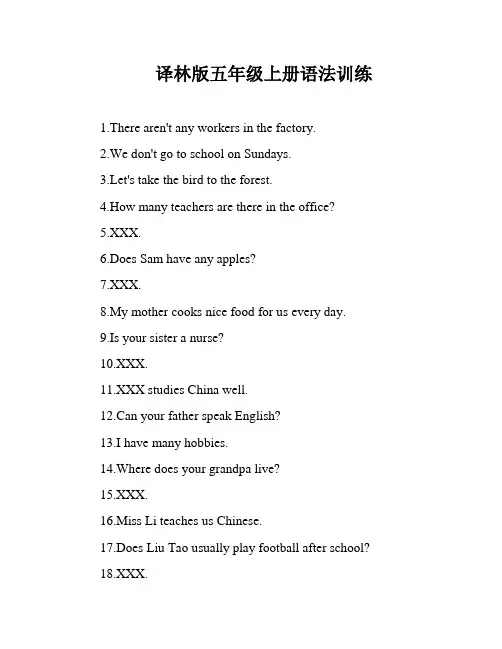
译林版五年级上册语法训练1.There aren't any workers in the factory.2.We don't go to school on Sundays.3.Let's take the bird to the forest.4.How many teachers are there in the office?5.XXX.6.Does Sam have any apples?7.XXX.8.My mother cooks nice food for us every day.9.Is your sister a nurse?10.XXX.11.XXX studies China well.12.Can your father speak English?13.I have many hobbies.14.Where does your grandpa live?15.XXX.16.Miss Li teaches us Chinese.17.Does Liu Tao usually play football after school?18.XXX.19.The little boy draws well.20.They are Lin Ping's apples.1.What does he study after school?2.Where does your e-friend come from?3.XXX.4.XXX.5.What does Ben usually do on Sundays?6.Do you like playing football。
Yes。
I do.7.Does Gao Shan like dancing。
No。
XXX't.21.There is some XXX.22.What does your father like to do?23.Skating is a great fun activity.24.Do not push us.25.I am able to swim.26.Bob and Liu Tao have different hobbies.27.I have an idea。
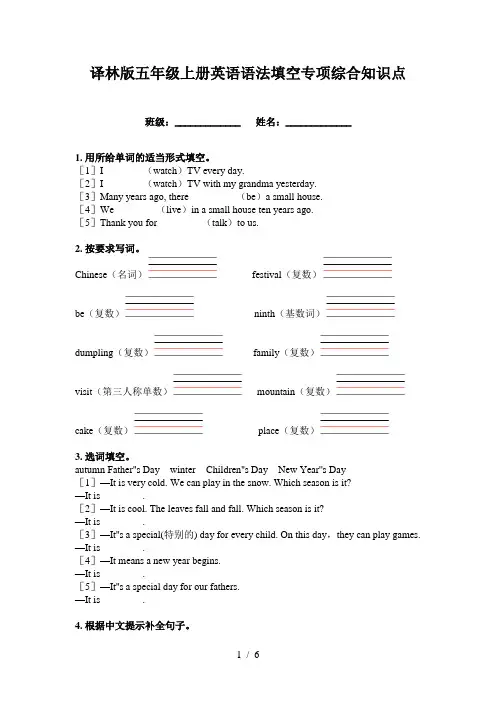
1 / 6 译林版五年级上册英语语法填空专项综合知识点 班级:_____________ 姓名:_____________ 1. 用所给单词的适当形式填空。 [1]I________(watch)TV every day. [2]I________(watch)TV with my grandma yesterday. [3]Many years ago, there _________(be)a small house. [4]We ________(live)in a small house ten years ago. [5]Thank you for_________(talk)to us.
2. 按要求写词。 Chinese(名词) festival(复数)
be(复数) ninth(基数词) dumpling(复数) family(复数) visit(第三人称单数) mountain(复数) cake(复数) place(复数) 3. 选词填空。 autumn Father''s Day winter Children''s Day New Year''s Day [1]—It is very cold. We can play in the snow. Which season is it? —It is ________. [2]—It is cool. The leaves fall and fall. Which season is it? —It is ________. [3]—It''s a special(特别的) day for every child. On this day,they can play games. —It is ________. [4]—It means a new year begins. —It is ________. [5]—It''s a special day for our fathers. —It is ________.
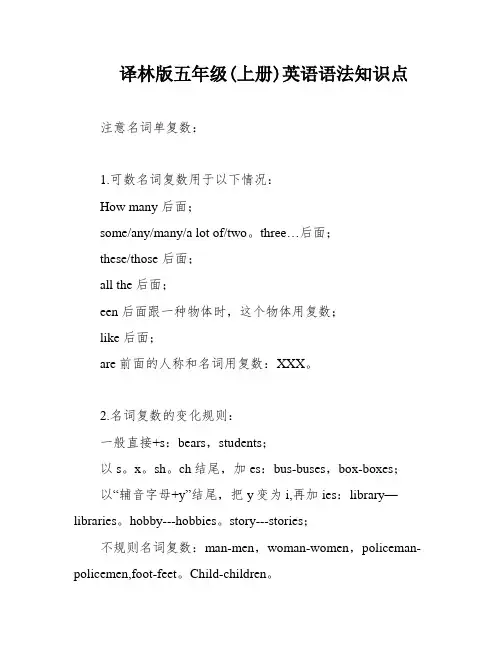
译林版五年级(上册)英语语法知识点注意名词单复数:1.可数名词复数用于以下情况:How many 后面;some/any/many/a lot of/two。
three…后面;these/those 后面;all the 后面;een 后面跟一种物体时,这个物体用复数;like 后面;are 前面的人称和名词用复数:XXX。
2.名词复数的变化规则:一般直接+s:bears,students;以s。
x。
sh。
ch结尾,加es:bus-buses,box-boxes;以“辅音字母+y”结尾,把y变为i,再加ies:library—libraries。
hobby---hobbies。
story---stories;不规则名词复数:man-men,woman-women,policeman-policemen,foot-feet。
Child-children。
3.不可数名词:water。
soup。
milk。
juice。
tea。
coffee。
bread(面包)。
rice(米饭)。
hair等等。
注意一般现在时动词的第三人称单数:1.肯定句中哪些情况下用第三人称单数:人称代词he。
she。
it作主语时;单个人名、地名或称呼作主语时;单数可数名词或"this / that / the+单数可数名词"作主语时;不可数名词作主语时;当数字或字母作主语时,等等。
2.动词第三人称单数变化规则如下:一般情况下,动词后面直接加s.如:works / plays/ reads;以s。
x。
sh。
ch或o结尾的动词,在后面加es。
例:teach-teaches。
watch-watches。
do-does。
go-goes;以辅音字母+y结尾的动词,把y变为i,再加es。
例:study- studies。
fly-flies。
carry-carries;不规则动词的第三人称单数:have—has;be—is。
人称代词、名词所有格及序数词单数一主格宾格物主Imemy二youyouyour三hehimhissheherherititits注意:所有格的形式是在名词后面加上’s,如:XXX’s book。
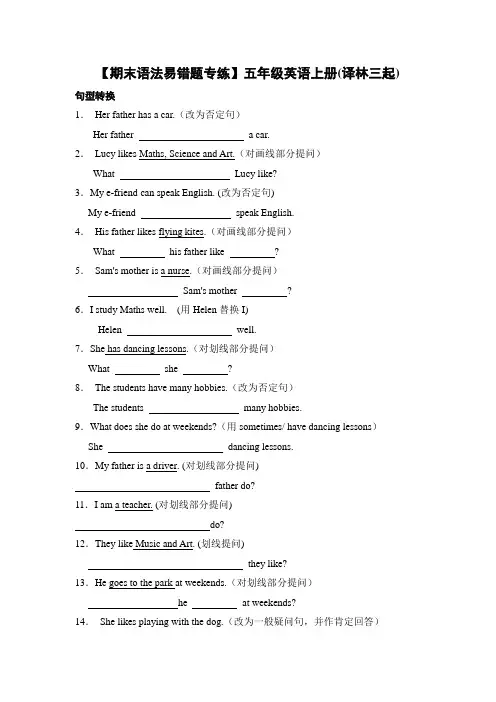
【期末语法易错题专练】五年级英语上册(译林三起) 句型转换1.Her father has a car.(改为否定句)Her father a car.2.Lucy likes Maths, Science and Art.(对画线部分提问)What Lucy like?3.My e-friend can speak English. (改为否定句)My e-friend speak English.4.His father likes flying kites.(对画线部分提问)What his father like ?5.Sam's mother is a nurse.(对画线部分提问)Sam's mother ?6.I study Maths well. (用Helen替换I)Helen well.7.She has dancing lessons.(对划线部分提问)What she ?8.The students have many hobbies.(改为否定句)The students many hobbies.9.What does she do at weekends?(用sometimes/ have dancing lessons)She dancing lessons.10.My father is a driver. (对划线部分提问)father do?11.I am a teacher. (对划线部分提问)do?12.They like Music and Art. (划线提问)they like?13.He goes to the park at weekends.(对划线部分提问)he at weekends?14.She likes playing with the dog.(改为一般疑问句,并作肯定回答)—she with the dog?—Yes, she .15.She lives in the UK. (改为一般疑问句,并作肯定回答) —she in the UK?—Yes, .16.My brother has a Chinese lesson today. (改成一般疑问句并作肯定回答)brother a Chinese lesson today?, he .17.Do they like swimming? (否定回答)__________________________________________18.She likes Music.(对划线部分提问)__________________________________________19.Does he have Chinese lessons?(肯定回答)__________________________________________20.I go on a picnic with my parents on Saturday.(对划线部分提问)__________________________________________21.My mother likes playing the piano.(改为否定句)My mother the piano.22.I often go to the park at weekends.(改成一般疑问句)often to the park at weekends? 23.The cake is blue and yellow.(对画线部分提问)is the cake?24.We always have a big dinner on Christmas Day.(改一般疑问句)always a big dinner on Christmas Day? 25.David wakes up early in the morning.(改否定句)David early in the morning. 26.Mr. Turkey looks sad.(把Mr. Turkey换成they)sad.27.He often buys a Christmas tree at Christmas.(对划线部分提问)he often at Christmas?28.Mr. Turkey likes Christmas.(改否定句)Mr. Turkey Christmas.29.What's wrong with him ? (改成同义句)What's with him?30.There is a house in the forest. (改为一般疑问句)a house in the forest?31.The clock is behind the book. (改为同义句)The book is the clock.32.There are some English books on the desk(改成单复句)There is on the desk.33.There are some butterflies in the flowers. (改为否定句)There butterflies in the flowers.34.There is some milk in the glass.(改成否定句)There milk in the glass.35.There are three bears in front of her.(对划线部分提问)36.There are seven desks in the reading room. (对画线部分提问)desks in the reading room? 37.There is a coat on the soft bed. (改为一般疑问句并做肯定回答)a coat on the soft bed?Yes,.38.The bear is beside the girl.(对画线部分提问)the bear?39.There are some apples on the table.(改为单数句)There on the table.40.There are six trees in the park.(对划线部分提问)are there in the park?41.There are some art rooms in the school. (改为单数句)There art in the school.42.There is one student in our classroom.(对划线部分提问)there inclassroom?43.I have a small cat.(对画线部分提问)What you ?44.She has an animal toy.(对画线部分提问)What she ?45.We have two animal friends.(用he 代替we)two animal friends.46.They don't have arms or legs.(改为同义句)They have arms legs.47.Susan likes watching films.(改为否定句)Susan watching films.48.Mike likes dancing.(改为一般疑问句,并作否定回答)Mike dancing? No, he . 49.I like collecting cards.(对画线部分提问)you like ?50.My brother likes singing.(改为否定句)My brother singing.答案部分1.doesn't;have2.subjects;does3.can;not4.does;doing5.What;does;do6.studies;Maths7.does;do8.don't;have9.sometimes;has10.What;does;your11.What;do;you12.What;subjects;do13.What;does;do14.Does;like;playing;does 15.Does;live;she;does16.Does;your;have;Yes;does 17.No, they don't.18.What subjects does he like?19.Yes, he does.20.What do you do on Saturday? 21.doesn't;like;playing22.Do;you;go23.What;colour24.Do;you;have25.doesn't;wake;up26.They;look27.What;does;do28.doesn't;like29.the;matter30.Is;there31.in;front;of32.an;English;book33.aren't;any34.isn't;any35.How many bears are there in front of her? 36.How;many;are;there37.Is;there;there;is38.Where39.is;an apple40.How;many;trees41.is;an;room42.How;many;students;are;your 43.do;have44.does;have45.He;has46.no;or47.doesn't;like48.Does;like;doesn't49.What;do;doing50.doesn't;like。
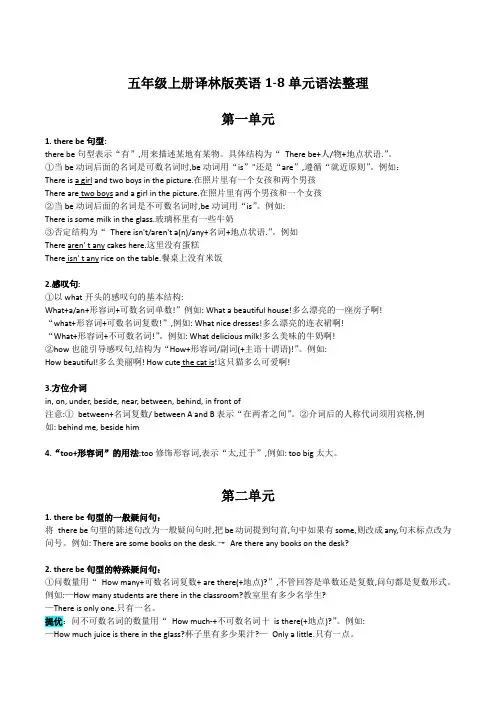
五年级上册译林版英语1-8单元语法整理第一单元1. there be句型:there be句型表示“有”,用来描述某地有某物。
具体结构为“There be+人/物+地点状语.”。
①当be动词后面的名词是可数名词时,be动词用“is”"还是“are”,遵循“就近原则”。
例如:There is a girl and two boys in the picture.在照片里有一个女孩和两个男孩There are two boys and a girl in the picture.在照片里有两个男孩和一个女孩②当be动词后面的名词是不可数名词时,be动词用“is”。
例如:There is some milk in the glass.玻璃杯里有一些牛奶③否定结构为“There isn't/aren't a(n)/any+名词+地点状语.”。
例如There aren' t any cakes here.这里没有蛋糕There isn' t any rice on the table.餐桌上没有米饭2.感叹句:①以what开头的感叹句的基本结构:What+a/an+形容词+可数名词单数!”例如: What a beautiful house!多么漂亮的一座房子啊!“what+形容词+可数名词复数!”,例如: What nice dresses!多么漂亮的连衣裙啊!“What+形容词+不可数名词!”。
例如: What delicious milk!多么美味的牛奶啊!②how也能引导感叹句,结构为“How+形容词/副词(+主语十谓语)!”。
例如:How beautiful!多么美丽啊! How cute the cat is!这只猫多么可爱啊!3.方位介词in, on, under, beside, near, between, behind, in front of注意:①between+名词复数/ between A and B表示“在两者之间”。
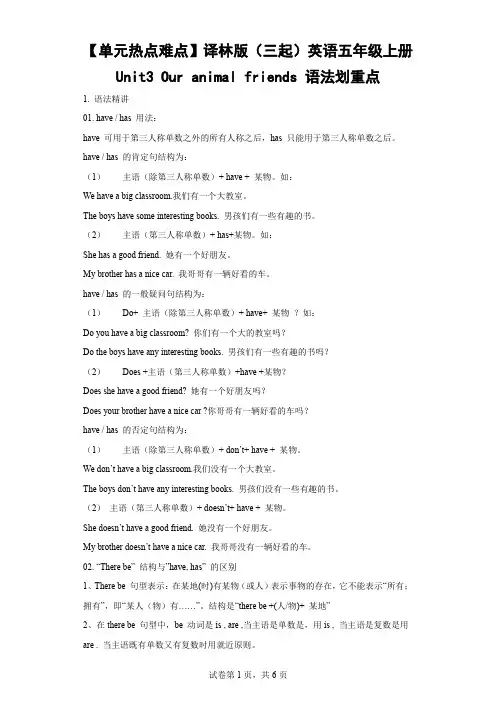
【单元热点难点】译林版(三起)英语五年级上册Unit3 Our animal friends 语法划重点1. 语法精讲01. have / has 用法:have 可用于第三人称单数之外的所有人称之后,has 只能用于第三人称单数之后。
have / has 的肯定句结构为:(1)主语(除第三人称单数)+ have + 某物。
如:We have a big classroom.我们有一个大教室。
The boys have some interesting books. 男孩们有一些有趣的书。
(2)主语(第三人称单数)+ has+某物。
如:She has a good friend. 她有一个好朋友。
My brother has a nice car. 我哥哥有一辆好看的车。
have / has 的一般疑问句结构为:(1)Do+ 主语(除第三人称单数)+ have+ 某物?如:Do you have a big classroom? 你们有一个大的教室吗?Do the boys have any interesting books. 男孩们有一些有趣的书吗?(2)Does +主语(第三人称单数)+have +某物?Does she have a good friend? 她有一个好朋友吗?Does your brother have a nice car ?你哥哥有一辆好看的车吗?have / has 的否定句结构为:(1)主语(除第三人称单数)+ don’t+ have + 某物。
We don’t have a big classroom.我们没有一个大教室。
The boys don’t have any interesting books. 男孩们没有一些有趣的书。
(2)主语(第三人称单数)+ doesn’t+ have + 某物。
She doesn’t have a good friend. 她没有一个好朋友。
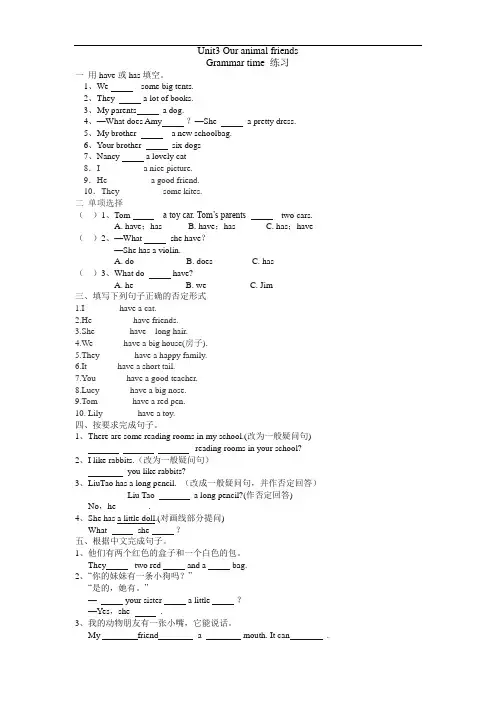
Unit3 Our animal friendsGrammar time 练习一用have或has填空。
1、We some big tents.2、They a lot of books.3、My parents a dog.4、—What does Amy ?—She a pretty dress.5、My brother a new schoolbag.6、Your brother six dogs7、Nancy a lovely cat8.I ________ a nice picture.9.He ________ a good friend.10.They _________ some kites.二单项选择()1、Tom a toy car. Tom’s parents two cars.A. have;hasB. have;hasC. has;have ()2、—What she have?—She has a violin.A. doB. doesC. has()3、What do have?A. heB. weC. Jim三、填写下列句子正确的否定形式1.I _______ have a cat.2.He _______ have friends.3.She _______ have long hair.4.We ______ have a big house(房子).5.They _______ have a happy family.6.It ______ have a short tail.7.You ______ have a good teacher.8.Lucy ______ have a big nose.9.Tom _______ have a red pen.10. Lily _______ have a toy.四、按要求完成句子。
1、There are some reading rooms in my school.(改为一般疑问句)reading rooms in your school?2、I like rabbits.(改为一般疑问句)you like rabbits?3、LiuTao has a long pencil. (改成一般疑问句,并作否定回答)_______ Liu Tao a long pencil?(作否定回答)No,he _______.4、She has a little doll.(对画线部分提问)What she ?五、根据中文完成句子。
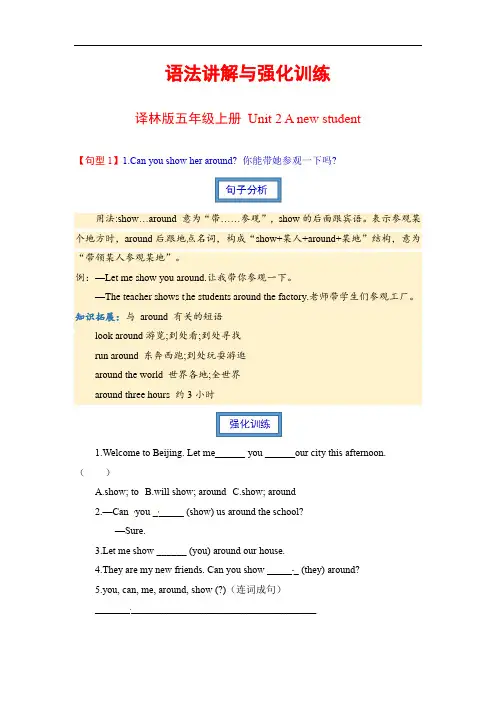
语法讲解与强化训练译林版五年级上册Unit 2 A new student【句型1】1.Can you show her around? 你能带她参观一下吗?用法:show…around 意为“带……参观”,show的后面跟宾语。
表示参观某个地方时,around后跟地点名词,构成“show+某人+around+某地”结构,意为“带领某人参观某地”。
例:—Let me show you around.让我带你参观一下。
—The teacher shows t he students around the factory.老师带学生们参观工厂。
知识拓展:与around 有关的短语look around游览;到处看;到处寻找run around 东奔西跑;到处玩耍游逛around the world 世界各地;全世界around three hours 约3小时1.Welcome to Beijing. Let me______ you ______our city this afternoon.()A.show; toB.will show; aroundC.show; around2.—Can you ______ (show) us around the school?—Sure.3.Let me show ______ (you) around our house.4.They are my new friends. Can you show ______ (they) around?5.you, can, me, around, show (?)(连词成句)____________________________________________【句型2】2.How many classrooms are there in our school? 我们学校有多少间教室?固定句型:How many+可数名词的复数形式+are there+介词短语?用法:how many 意为“多少”,对there be 句型中主语的数量进行提问,不管主语是单数形式还是复数形式,一般都用复数形式提问,因为问话人不知道具体的数量是多少,而且many只能接可数名词的复数形式,所以be 动词一定要用are。
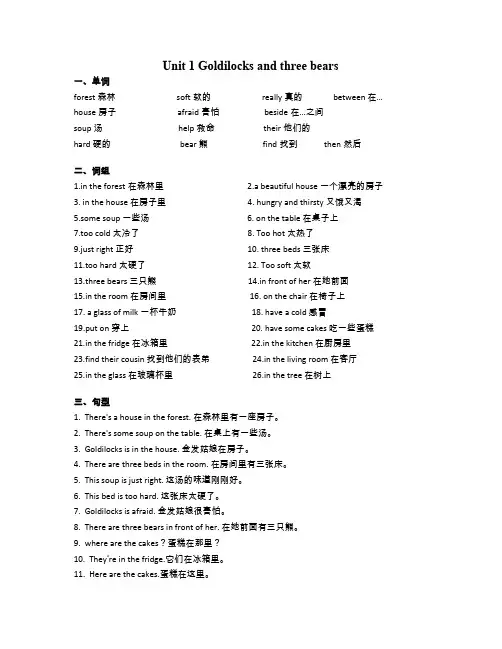
Unit 1 Goldilocks and three bears一、单词forest 森林 soft软的 really真的 between 在…house房子 afraid害怕 beside在…之间soup汤 help救命 their他们的hard 硬的 bear 熊 find找到 then然后二、词组1.in the forest在森林里2.a beautiful house一个漂亮的房子3. in the house 在房子里4. hungry and thirsty 又饿又渴5.some soup 一些汤6. on the table 在桌子上7.too cold 太冷了 8. Too hot 太热了9.just right 正好 10. three beds 三张床11.too hard 太硬了 12. Too soft 太软13.three bears 三只熊 14.in front of her 在她前面15.in the room 在房间里 16. on the chair 在椅子上17. a glass of milk 一杯牛奶 18. have a cold 感冒19.put on 穿上 20. have some cakes 吃一些蛋糕21.in the fridge 在冰箱里 22.in the kitchen 在厨房里23.find their cousin 找到他们的表弟 24.in the living room 在客厅25.in the glass 在玻璃杯里 26.in the tree 在树上三、句型1. There's a house in the forest. 在森林里有一座房子。
2. There's some soup on the table. 在桌上有一些汤。
3. Goldilocks is in the house. 金发姑娘在房子。
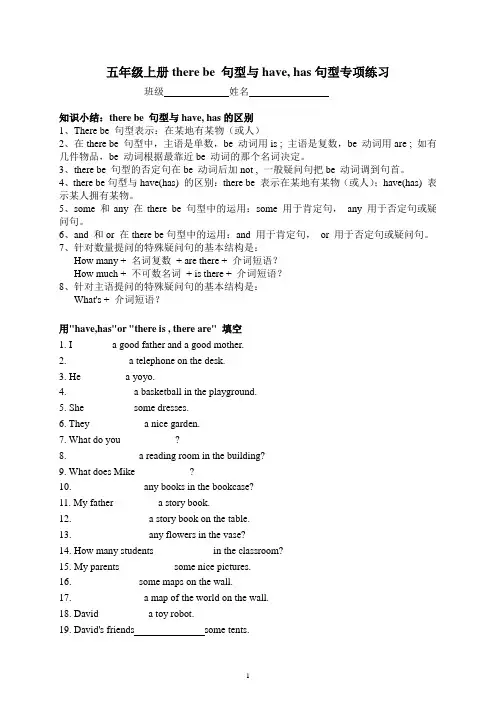
五年级上册there be 句型与have, has句型专项练习班级姓名知识小结:there be 句型与have, has的区别1、There be 句型表示:在某地有某物(或人)2、在there be 句型中,主语是单数,be 动词用is ; 主语是复数,be 动词用are ; 如有几件物品,be 动词根据最靠近be 动词的那个名词决定。
3、there be 句型的否定句在be 动词后加not , 一般疑问句把be 动词调到句首。
4、there be句型与have(has) 的区别:there be 表示在某地有某物(或人);have(has) 表示某人拥有某物。
5、some 和any 在there be 句型中的运用:some 用于肯定句,any 用于否定句或疑问句。
6、and 和or 在there be句型中的运用:and 用于肯定句,or 用于否定句或疑问句。
7、针对数量提问的特殊疑问句的基本结构是:How many + 名词复数+ are there + 介词短语?How much + 不可数名词+ is there + 介词短语?8、针对主语提问的特殊疑问句的基本结构是:What's + 介词短语?用"have,has"or "there is , there are" 填空1. I________a good father and a good mother.2. ____________a telephone on the desk.3. He_________a yoyo.4. _____________a basketball in the playground.5. She__________some dresses.6. They___________a nice garden.7. What do you___________?8. ______________a reading room in the building?9. What does Mike___________?10. ______________any books in the bookcase?11. My father_________a story book.12. _______________a story book on the table.13. _______________any flowers in the vase?14. How many students____________in the classroom?15. My parents___________some nice pictures.16. _____________some maps on the wall.17. ______________a map of the world on the wall.18. David__________a toy robot.19. David's friends some tents.20. many children on the hill.21. This desk four legs.22. some books on the desk.23. Everyone a dictionary in my class.24. no knives in the room.25. I a new sweater.26. some flowers and a desk in the room.用恰当的be动词填空。
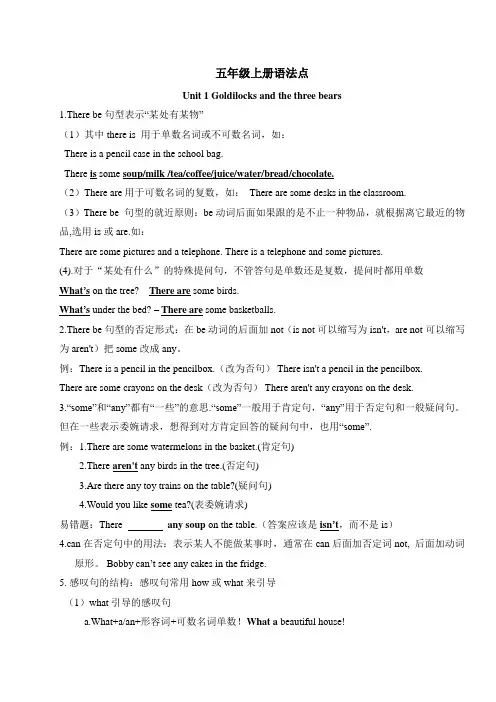
五年级上册语法点Unit 1 Goldilocks and the three bears1.There be句型表示“某处有某物”(1)其中there is 用于单数名词或不可数名词,如:There is a pencil case in the school bag.There is some soup/milk /tea/coffee/juice/water/bread/chocolate.(2)There are用于可数名词的复数,如: There are some desks in the classroom.(3)There be 句型的就近原则:be动词后面如果跟的是不止一种物品,就根据离它最近的物品,选用is或are.如:There are some pictures and a telephone. There is a telephone and some pictures.(4).对于“某处有什么”的特殊提问句,不管答句是单数还是复数,提问时都用单数What’s on the tree? There are some birds.What’s under the bed? –There are some basketballs.2.There be 句型的否定形式:在be动词的后面加not(is not可以缩写为isn't,are not可以缩写为 aren't)把some 改成any。
例:There is a pencil in the pencilbox.(改为否句) There isn't a pencil in the pencilbox.There are some crayons on the desk(改为否句) There aren't any crayons on the desk.3.“some”和“any”都有“一些”的意思.“some”一般用于肯定句,“any”用于否定句和一般疑问句。
语法讲解与强化训练译林版五年级上册Unit 3 Our animal friends【句型1】1.One is red and the other is black.一个是红色的,另一个是黑色的。
“one…,the other.”意为“一个……·另一个……”,通常针对两者而言,指两个人或物中的另一个时,只能用the other,不能用another,此时的other作代词。
例:—I have two friends. One is tall and the other is short.我有两个朋友,一个是高的,另一个是矮的。
—I have two pens. One is red and the other is black.我有两个钢笔,一个是红色的,另外一个是黑色的。
知识拓展:“one…,the others….”指三者或三者以上范围中的“一个……·,其他的……”“one …another…”指不确定范围的人或物中的“一个……,另一个……”。
例:—I have three caps.One is red,the others are black.我有三顶帽子。
一顶是红色的,其他的是照色的。
—He finished one cup of tea and then asked for another cup.他喝完了一杯茶,然后要另一杯。
1.Lucy has two dolls. _______ is big and _______ is small. ( )A.One; anotherB.One; the otherC.One; other2.He has two rooms. ________is a big bedroom, ________is a reading room.( )A.One; otherB.One; the otherC.The one; other3.I have two fish. One is red,________is black. ( )A.otherB.othersC.the other4.is, one, black, the, white, and, other, is (.)(连词成句)______________________________________【句型2】2.They have no legs or arms,but they have big tails.它们没有腿也没有胳膊,但它们有大尾巴。
五年级上册语法知识+练习 Unit 1 Goldilocks and the three bears 知识点回顾: 1.There is +可数名词单数/不可数名词---There_____ an apple on the table. ---There_____some bread on the table. (常见的不可数名词:soup,juice,tea,milk,coffee,rice,bread,food,meat肉) 2.There are+可数名词复数---There_____some apples on the table. 3.There be 句型的________原则---There______an apple and some pears in my bag. ---There______some pears and an apple in my bag. 4..some用于肯定句,any用于疑问句或者否定句;a..---You can have_______cakes. b.---There aren’t_______cakes here. C.---Do you have ______cakes? 5.动词/介词+宾格---There are three bears in front of ________(she). ---Let ______(I)have a look. 6.写宾格:I_________ we________you______they______she_______he________it________
小练笔:用所给词的适当形式填空。 1.There______(be)some beds in the house. 2.There______(be)some rice in the bowl(碗). 3.There______(be)a desk ,a chair and a football in the room. 4.There______(be)some bread and some apples on the table. 5.There______(be)any books in the school bag. 6.There______(be)any apple juice in the fridge. 7.There______(be)an orange and three pears in the basket. 8.I can see the pen between the _______(desk). 9.There________(be)any food in the fridge. 10.We_______(have)a new house. 11.The teacher is beside_______(he). 12.I’d like some______(soup). 13.How many_______(bear)are there? 14.I like________(cake) very much. 15.—______(be)you tired?—No,I’m not. 16.Let’s______(eat) some cakes,Linda.Ok! 17.I like this_______(apple). 18.Look,they are________(they)books. 19.Here_______(be)the pie. 20.My uncle______(have)a cold. 21.I can see a cat beside_______(she).
根据首字母提示填空 。 1.Look,there is a chair b_______ the bed. 2.I live in a new h_________with my parents. 3.She’s very h_________.There isn’t any cakes in the fridge. 4.This soup is too c______. 5.The girl is t________.She wants to go to bed. 6.The boy is a________to see a bear.
Unit 2 A new student
知识点回顾: 1. Is there an apple on the table?肯定回答______________;否定回答_______________. 2. Are there any apples on the table?肯定回答____________;否定回答______________. 3. How many +可数名词复数---How many_______(student)are there in your school? (注意people:人,人们,单复数同形---How many_______(people)are there in your family? 4.基数词表示数量,序数词表示顺序---There are_______(three)floors in my school. (注意:序数词前面必须要有“the”)--- Our classroom is on ________(three)floor. 5.动词/介词+宾格---Push _____(I),Bobby.(Push 表示推,是动词) ---There are some flowers in front of______(he)(of是介词) 6.Let +宾格+动词原形---Let’s________(go) and _______(play)./Let me ______(see).
小练笔:用所给词的适当形式填空。 1.There are 24______(classroom) in your school. 2._____(we)classroom is nice and clean. 3.Let’s go and _____(have)a look. 4._____(this)are the music rooms. 5.Let me show ______(she)around. 6.They are on the_______(two)floor. 7.There are two_________(art room)on the______(one)floor. 8.There’re_______(three) floors iin this building(大楼). 9.It’s time_________(have)lunch. 10.Don’t push_______(she),please. 11.There_________(be)three cups of tea on the table. 12.Look!Those are________(they)new books. 13.---Can I have_________(some)milk? ---Sorry,There isn’t__________(some) milk here. 14.How many________(book)are there on the desk? 15.________(be)there a plate on the table? 16.There_________(be not)_________(some)birds in front of the house. 17.The computer room is on________________(one)floor. 18.Are there any________(library)in your school?
根据中文及首字母提示填空。 1.How many classrooms are there________________________(在我们的学校)? 2.My classroom is____________________________(在二楼). 3.Is there________________________(一间音乐教室)? 4.Bobby and Sam are___________________________(在操场上). 5.Now Bobby is___________________________(在秋千上). 6.The box is_____________________(如此重). 7.My father is sitting on a s_______sofa. 8.H______me!There is a big tiger. 9.They f_______their cousin in his bedroom. 10.There’s a garden in f________of the house. 11.There is a picture b________the two windows. 12.They aren’t a_______books on the desk.
Unit 3 Our animal friends
知识点回顾: 1.鼻子,嘴巴,尾巴等只有一个,用单数,前面要加a---I have _____big mouth. 2.耳朵,眼睛,手臂,腿等成双成对的,用复数,后面要加“s”---I have big ____(eye). (注意要么单数要么复数,不要出现a big eyes,a long ears等错误写法) 3.can/can’t/don’t+动原---Itcan_____(jump) and ____(run)./Don’t_____(shout). 4.he, she, it 是第三人称单数,后面用动词三单形式has,疑问句用Does提问; ---She_____a dog.---Does she have a dog?Yes,____________.No,______________. ---He _____a bird.---Does he have a bird?Yes,___________.No,______________. 5.I,we,you ,they不是第三人称单数,后面用动词原形have,疑问句用Do提问; ---I_____a dog.---Do you have a dog?Yes,______________.No,________________. ---We_____a cat.---Do you have a cat ?Yes,______________.No,________________. ---They _____a parrot.---Do they have a parrot?Yes,___________.No,___________. 6.下面四句话必须要会A:kangaroos B: polar bears C: bald eagles D: pandas ---You can see_________in China. ---You can see_________in the US. ---You can see_________in Canada. ---You can see_________in Australia.